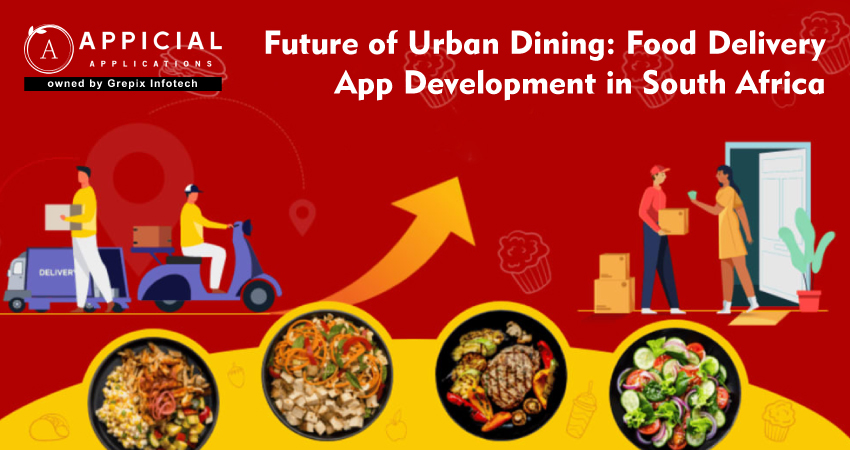
Future of Urban Dining: food delivery app development in South Africa
Imagine this.
You're stuck in Cape Town traffic after a long day. Your stomach rumbles, but you're too tired to cook. You wish your favorite dish could arrive at your door ready and warm.
Or it’s Sunday in Durban. You’re craving that local bunny chow from your go-to spot. But you’re still in pajamas, enjoying your coffee. You wish you could order with a tap and get your meal while you relax.
This is where food ordering apps come alive.
Urban life in South Africa is fast. People work long hours. They juggle family, studies, and side hustles. They want tasty meals without the stress of cooking or driving out.
You’ll get a clear look at development costs and timelines, so you know what it takes to build an app that fits the South African lifestyle. We explain how food ordering apps and restaurant app solutions can help local restaurants grow while serving busy customers who value their time. Lastly, we discuss how Appicial Applications can assist you in creating a popular food delivery mobile app. With the correct strategy, your app can provide customers with greater convenience in their daily lives while also assisting restaurants in growing. This guide will provide you with the clarity you need to proceed if you wish to capitalize on South Africa's expanding appetite for meal delivery technology.
Food delivery app development in South Africa isn’t just about convenience.
It’s about saving time, keeping families fed, and helping local restaurants reach more people. It’s about meeting real needs in everyday life.
Let’s dive in!
South Africa's urban dining landscape is evolving quickly. People want their meals delivered quickly, stress-free, and without having to get out of their couches after a long day. Families in Johannesburg would rather eat hot dinners at home and avoid traffic. Students in Cape Town want affordable lunches between lectures. Professionals in Durban want a quick coffee and pastry delivered before meetings. This is why food ordering apps and meal delivery tech are booming. This blog unpacks why now is the right time for food delivery app development in South Africa. We break down what customers want, what restaurants need, and how you can meet both. You’ll discover must-have app features like live tracking, secure payments, loyalty programs, and clear menus. We discuss the best technology stack to build a fast, stable app that customers trust, and those restaurants find easy to use. We also explore real challenges like traffic, payment issues, local flavor gaps, and rider safety. These are not obstacles; they are opportunities for your app to stand out.
Why Invest in Food Delivery App Development in South Africa?
South Africa’s cities are buzzing. Streets are busy. People are always on the move. But one thing doesn’t change: the love for good food. Here’s why building food ordering apps makes sense now:
- Busy Lifestyles: People are looking for quick, reliable meal options. They want dinner on the table without the rush.
- High Smartphone Use: More people are shopping and banking on their phones. This routine is ideal for food delivery.
- Support Local Restaurants: Your restaurant app solutions help small eateries serve customers without the heavy cost of marketing.
- Growth of Contactless Payments: People are using SnapScan, card payments, and M-Pesa more than ever. Your app can make payments quickly and safely.
- Cloud Kitchen Expansion: Ghost kitchens are popping up in major cities. They depend on meal delivery tech to get meals to customers.
- Post-Pandemic Habits: Many people got used to home deliveries during lockdowns. They still want that comfort and safety.
Your mobile app for food delivery can help customers get the meals they love while supporting local businesses.
What are the Must-Have Features for a Food Delivery App?
Here’s what it should have:
- Easy Sign-Up: Let users create an account quickly using email, phone, or social profiles.
- Live Order Tracking: People want to see where their meal is in real time.
- Multiple Payment Options: Support SnapScan, card, and M-Pesa so customers can pay how they prefer.
- Smart Search: Allow customers to search by cuisine, price, or dietary needs.
- Push Notifications: Keep customers updated on order progress and special deals.
- In-App Chat or Call: Let customers reach out if they need to change delivery details or ask a question.
- Loyalty Rewards: Offer discounts or points for repeat orders to encourage loyalty.
- Ratings and Reviews: Help customers trust your service and give restaurants feedback.
- Restaurant Dashboard: Your restaurant app solutions should let eateries manage orders without stress.
- Driver App: For a seamless delivery, delivery riders require clear orders, maps, and customer information. These features will increase customer trust and make your food ordering apps easy to use.
What are the Major Technology stacks and Architectures for a Food Ordering App?
Your meal delivery tech needs a strong, stable foundation.
Frontend
You can create your food delivery mobile app for both iOS and Android at the same time while maintaining a consistent look and feel by using Flutter or React Native. There should be no confusion or slow loading when users search for meals, place orders, and track deliveries.
Backend
The backend is the engine of your meal delivery tech. It handles everything customers and restaurants don’t see but feel when it works well.
Database
Your data will be safe and accessible if you use PostgreSQL or MongoDB. You can easily view order histories, determine which dishes are most popular, and effectively handle customer service concerns.
Cloud Hosting
As your company expands, using AWS or Google Cloud helps you keep data safe and scalable while maintaining dependable uptime.
Payments
Integrate card payments, M-Pesa, PayFast, and SnapScan so that your clients can select the option that best suits their needs. This flexibility reduces abandoned carts and failed orders.
Maps and Tracking
One of the best features in food ordering apps is live tracking. People love seeing where their order is and when it will arrive.
Push Notifications
Sending real-time updates on order approval, setup, dispatch, and delivery is possible with Firebase Cloud Messaging. To keep customers interested, you can also send out promotions or reminders about loyalty benefits.
Admin Dashboard
A clean dashboard to manage users, orders, and reports easily.
This stack ensures your mobile app for food delivery remains fast and dependable as your business grows.
Also Read: Unlocking the Potential of food delivery app development in Kenya
What are the Challenges and Market Gaps in South Africa?
The opportunities are big, but there are challenges to plan for.
- Traffic Delays: Delivery times can be affected by heavy traffic, especially in cities. Optimized routing is key.
- Connectivity Issues: Some areas may have poor network coverage. Your app should work even with slow connections.
- Payment Failures: Not every payment will go through smoothly. Multiple payment options reduce failed transactions.
- Local Flavour Gaps: Global apps miss local favorites. South Africans love meals like pap, bunny chow, and boerewors rolls. Include them.
- Delivery Costs: High delivery fees can discourage users. Transparent pricing helps.
- Rider Safety: Riders need to feel safe, especially for late-night deliveries.
- Restaurant Tech Challenges: Not every restaurant is comfortable with technology. Your restaurant app solutions should be easy to use.
These are not dead ends. They are areas where your food ordering apps can truly stand out in the market.
Estimated Development Cost & Timeline
Here’s what to expect when budgeting for your meal delivery tech:
- MVP Version: $8,000 – $12,000
- Full-Feature App: $15,000 – $25,000
- Enterprise App: $30,000 and above
Timeline:
- Research & Planning: 2 weeks
- UI/UX Design: 3-4 weeks
- Backend and API Development: 6-8 weeks
- App Development: 6-8 weeks
- Testing: 2-3 weeks
- Launch: 1-2 weeks
Total time: Around 4-5 months for a fully tested mobile app for food delivery, ready for South Africa’s market.
How Appicial Applications Can Help?
At Appicial Applications, we know what it takes to build food ordering apps that people love.
- We design apps that load fast and look clean on every device.
- We set up SnapScan, M-Pesa, and card payments for easy checkout.
- We build restaurant app solutions that help local owners manage orders easily.
- We create smooth meal delivery tech with rider apps for live tracking and updates.
- We handle post-launch support so your app keeps running well.
- We add data tracking so you can see what meals are popular and how to improve.
Your idea deserves to shine. We help you bring it to life with reliable mobile app for food delivery development that fits the South African lifestyle.
Conclusion
Urban dining is changing in South Africa. People want good meals delivered with no hassle. They want food ordering apps they can trust. They want local flavors, easy payments, and quick service.
Investing in food delivery app development in South Africa is not just a business trend. It allows you to increase your income while giving back to the community.
You can take advantage of this expanding market and retain clients with the correct features, technology, and strategy.
Appicial Applications is ready to walk this journey with you. Let’s build your mobile app for food delivery and help you serve South Africa better, one meal at a time.
Looking out to start your own venture like Zomato? Try out our MasalaDish Zomato Clone, the easiest way to kick-start your taxi business.Author's Bio

Vinay Jain is the Founder at Grepix Infotech and brings over 12 years of entrepreneurial experience. His focus revolves around software & business development and customer satisfaction.
Back to blog list




